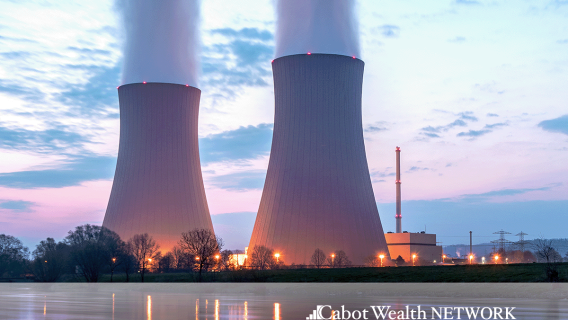Earlier this month, the ADVANCE Act, a bipartisan bill to accelerate the development of nuclear energy, was signed into law.
Of note was the ease of passage, as it sailed through the Senate by a vote of 88-2 and the House by a vote 393-13.
This remarkable bipartisan success leveraged support for action on climate change, technology, jobs and economic and national security and acknowledged the foundational importance of advanced nuclear energy, something I’ve been vocal about for many years.
One immediate beneficiary of the bill is likely TerraPower, a Bill Gates-backed private company that has broken ground to build a $4 billion Natrium reactor in Wyoming on the site of an old coal plant, but which is stymied by the need for a key permit. Its advanced reactor uses sodium cooling rather than water cooling – a key safety breakthrough.
Much of the renewed interest in nuclear energy lies at the feet of the surging demand for artificial intelligence (AI), as AI data centers are ravenous consumers of electricity.
Goldman Sachs estimates that power demand for data processing and storage will grow 160% by the end of the decade.
This means that companies looking to make AI chips faster are going to need a larger share of the world’s electricity output. That additional power will have to be sourced from coal, natural gas, renewables, and nuclear power.
Renewables have expanded but have only made a small dent in the world’s dependence on fossil fuels. This leaves the growth of nuclear energy as the only other cleaner solution to generating the world’s energy needs. Nuclear energy is virtually emissions-free energy, takes up very little land, consumes very little fuel, contributes to fuel diversification and the stability of the grid, creates skilled, well-paid jobs, and produces very little waste.
Then there is the important issue of reliability. Nuclear power plants on average operate at full power on 336 out of 365 days per year. Hydroelectric systems deliver power on average 138 days per year, wind turbines 127 days per year and solar electricity only 92 days per year. Even plants powered with coal or natural gas only generate electricity about half the time for various reasons. Nuclear power is a clear leader in reliability.
In addition, nuclear plants can run for 100 years while solar panels and wind turbines last only about 20 years. No wonder nuclear power accounts for 70% of France’s electricity mix and 30% for Switzerland, South Korea, and Sweden.
In the public’s perception, there are two issues with nuclear power: the risk of accidents, and the question of disposal of nuclear waste.
There have been three large-scale accidents involving nuclear power reactors since the onset of commercial nuclear power in the 1950s, but these incidents all represent old technology and water cooling.
Nuclear waste disposal, although a continuing political problem in the U.S., is not any longer a technological problem. More than 90% of spent fuel could be recycled to extend nuclear power production by hundreds of years and can be stored safely in impenetrable concrete-and-steel dry casks on the grounds of operating reactors, its radiation slowly declining.
Advanced nuclear energy can be cheaper than natural gas, more dependable than solar or wind, and as it scales up, it could even be cheaper than coal when you take into consideration costs of emissions.
The United States has long led the world in developing and deploying nuclear energy technologies, providing about 30% of global nuclear energy production and 52% of America’s carbon-free electricity in 2020, according to the Department of Energy, even though American commercial nuclear development has markedly slowed.
China is now the leader with plans for at least 150 new reactors over the next fifteen years. China is building 22 of the 58 reactors under construction around the world, according to the International Atomic Energy Agency.
In comparison, the nuclear fleet in Western economies is 35 years old on average, and many plants are nearing the end of their designed lifetimes. With advancing age, plants are beginning to close, with 25% of existing nuclear capacity in advanced economies probably shutting down by 2025.
3 American Nuclear Power Companies Paving the Way Forward
There are significant American beachheads to support and validate the expansion of nuclear energy in America. For example, for Duke Energy (DUK), 40% of the electricity the company produces comes from nuclear power. America has 94 reactors that generate about 20% of our electricity, but we have not built one new plant in the last 25 years.
This brings me back to Bill Gates, who has been exploring simpler, cheaper reactors since 2008 and recently stated, “I put in over a billion, and I’ll put in billions more.”
Gates is banking on costs coming down with scale so that nuclear can compete with coal.
American companies such as BWX Technologies (BWXT), X-energy, and UltraSafe Nuclear (both private) are all working on new concepts, such as the advanced small modular reactor (SMR) design being marketed by NuScale (SMR), a sodium fast reactor, and a modular high temperature gas-cooled reactor.
For example, NuScale is developing a small reactor that can generate 77 megawatts of electricity and is pushing through the U.S. Nuclear Regulatory Commission’s licensing process. The first customer for the NuScale design is Utah Associated Municipal Power Systems, which has plans to commission a plant in Idaho by 2027.
Because they are smaller, SMRs generate about one-third the energy of a conventional nuclear reactor and can be prefabricated and shipped to the site so they are cheaper to install.
The above stock ideas are promising, but last week, I offered a better nuclear power play idea in the Cabot Explorer based on the need for more fuel to scale up nuclear energy projects such as TerraPower.
Join the Cabot Explorer today and find out more about this stock trading at just nine times trailing earnings as well as other dominating and disruptive stocks that can help you build wealth.
